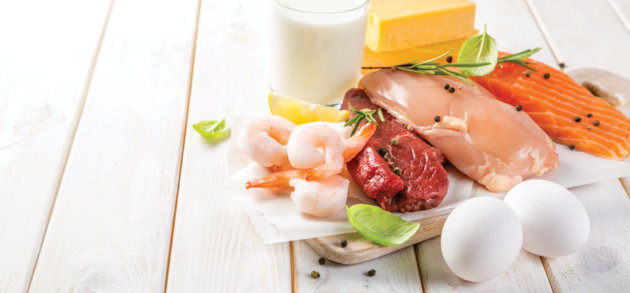
Recipe to Retail: Little-known facts about protein
By Birgit Blain
Food Trends Meat &Poultry Plant-based foods Editor pick health Photo © anaumenko / Adobe Stock
Photo © anaumenko / Adobe Stock Protein remains high on the list of consumers’ preferred claims. Thousands of food products are also touting protein content.
Protein is a complex nutrient that few people understand. It’s not as simple as buying products with high protein claims and tallying up how many grams are consumed. I would like to share learnings from a research study and metabolic trial in which I participated, conducted by the University of Toronto Faculty of Kinesiology & Physical Education.
Our body requires daily protein intake to support the immune system and maintain bodily functions such as:
- maintenance of muscle size, strength and function;
- building new muscle;
- tissue growth;
- regulation of the metabolism, digestion, blood sugar, calcium absorption, appetite, sleep, and mood; and
- production of hemoglobin, hormones, collagen, and energy.
Protein is a macronutrient comprising 20 unique amino acids with different functions. Eleven amino acids are produced by our body. However, the remaining nine cannot be produced at a rate sufficient to support bodily needs. Those nine, referred to as essential amino acids (EAAs) are histidine, isoleucine, leucine, lysine, methionine, phenylalanine, threonine, tryptophan, and valine.
Muscle protein synthesis (MPS) is the process of the body utilizing amino acids from food protein to build muscle protein. The process is necessary to build new protein and offset muscle protein breakdown by repairing and replacing old or damaged proteins to maintain muscle quality and quantity. This is particularly important as we age to counteract muscle loss, known as sarcopenia.
The 3 T’s of protein consumption—total, type and timing—are of prime importance to optimize protein intake.
Total daily consumption
The recommended daily protein intake varies depending on age, sex, weight, height, activity level, muscle quality and quantity and health goals.
According to the University of Toronto research group and stable isotope tracer studies they have conducted, current recommended daily allowances (RDAs) of 1.2 g per kg of body weight and estimated average requirements (EARs) of 0.8 g per kg of body weight, are not sufficient. Daily recommendations for most active adults range from 1.5 g to 2 g per kg of body weight.
Type of protein
Animal sources—meat, fish, eggs, and dairy—provide all essential amino acids, including a good source of leucine to enhance muscle remodelling.
Leucine is primarily metabolized by skeletal muscle. According to the leucine threshold hypothesis, our body needs from 2 to 2.5 g of leucine per meal to stimulate MPS.
Individual plant sources are incomplete proteins, as they only contain some of the essential amino acids in sufficient quantities. Therefore, consuming a variety of protein sources is beneficial.
Timing
The human body can only utilize a certain amount of protein for protein synthesis at any given time. Therefore, protein intake should be equally divided throughout the day. An additional protein rich serving before bedtime facilitates MPS during the night.
Do vegans get enough protein?
Vegans and flexitarians require a variety of plant-based protein sources to ensure they are getting all essential amino acids in appropriate amounts. Protein dense plant sources include soy, black beans, lentils, quinoa and mycoprotein from Fusarium venenatum fungus.
Regulatory requirements
Making protein claims is complicated, with restrictive and very specific requirements under Health Canada labelling regulations, which also apply to all forms of advertising. There are opportunities to make claims, such as ‘source of protein’ and ‘rich in protein,’ when the required conditions are met.
It’s important to note that statements, such as ‘high quality protein’ and ‘source of essential amino acids,’ are not permitted. However, if the food qualifies for a ‘source of protein’ claim, there is an option to declare the quantity of all nine essential amino acids, in grams per serving, outside the Nutrition Facts table.
Marketing opportunity
Products with ‘complete protein’ profiles raise the bar for protein enriched foods and have a compelling point of difference when supported by an educational marketing campaign.
As a CPG food consultant, Birgit Blain helps clients think strategically to build a sustainable brand. Her experience includes 17 years with Loblaw Brands and President’s Choice. Contact her at birgit@bbandassoc.com or learn more at www.bbandassoc.com.
This column was originally published in the October 2023 issue of Food in Canada.
Print this page